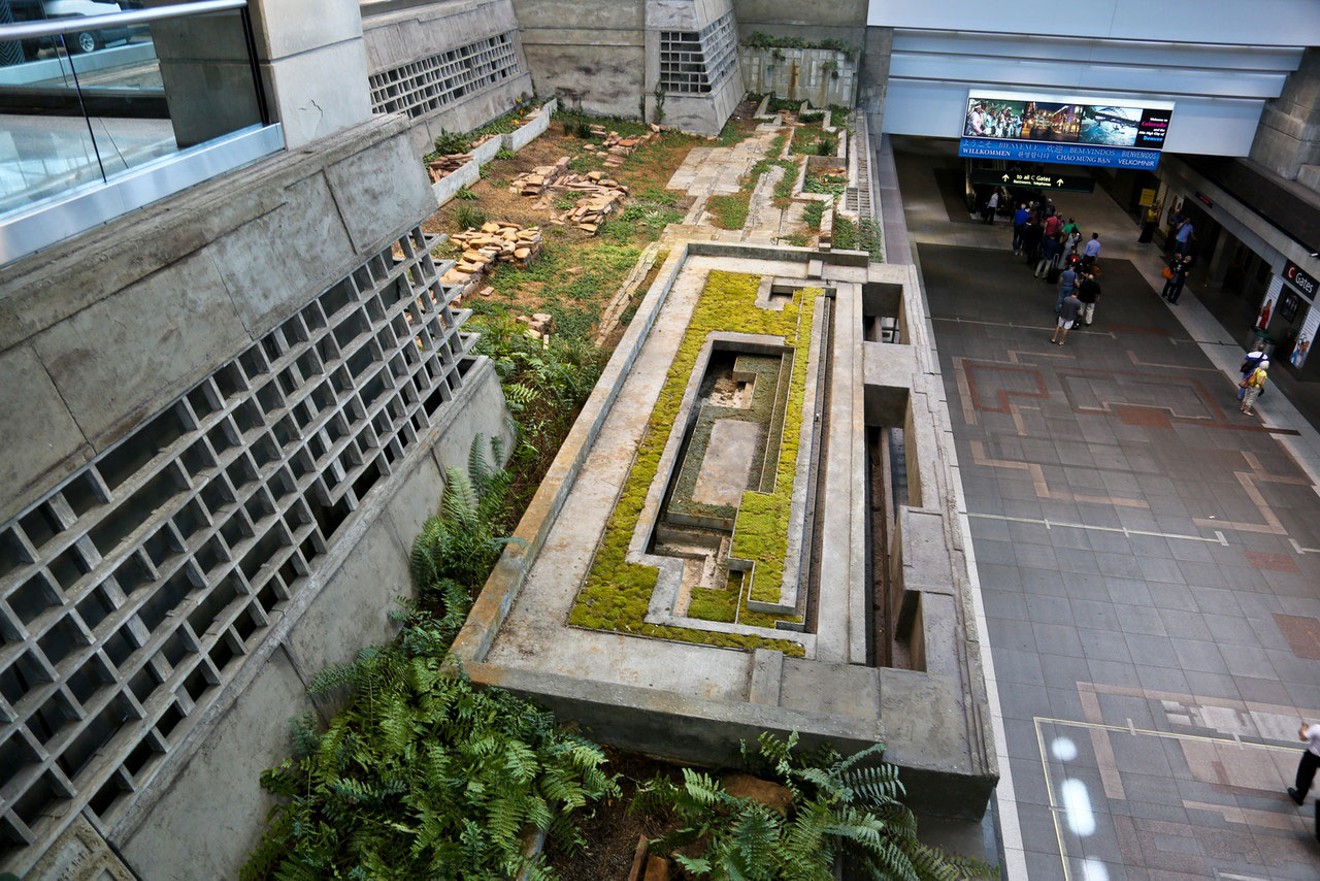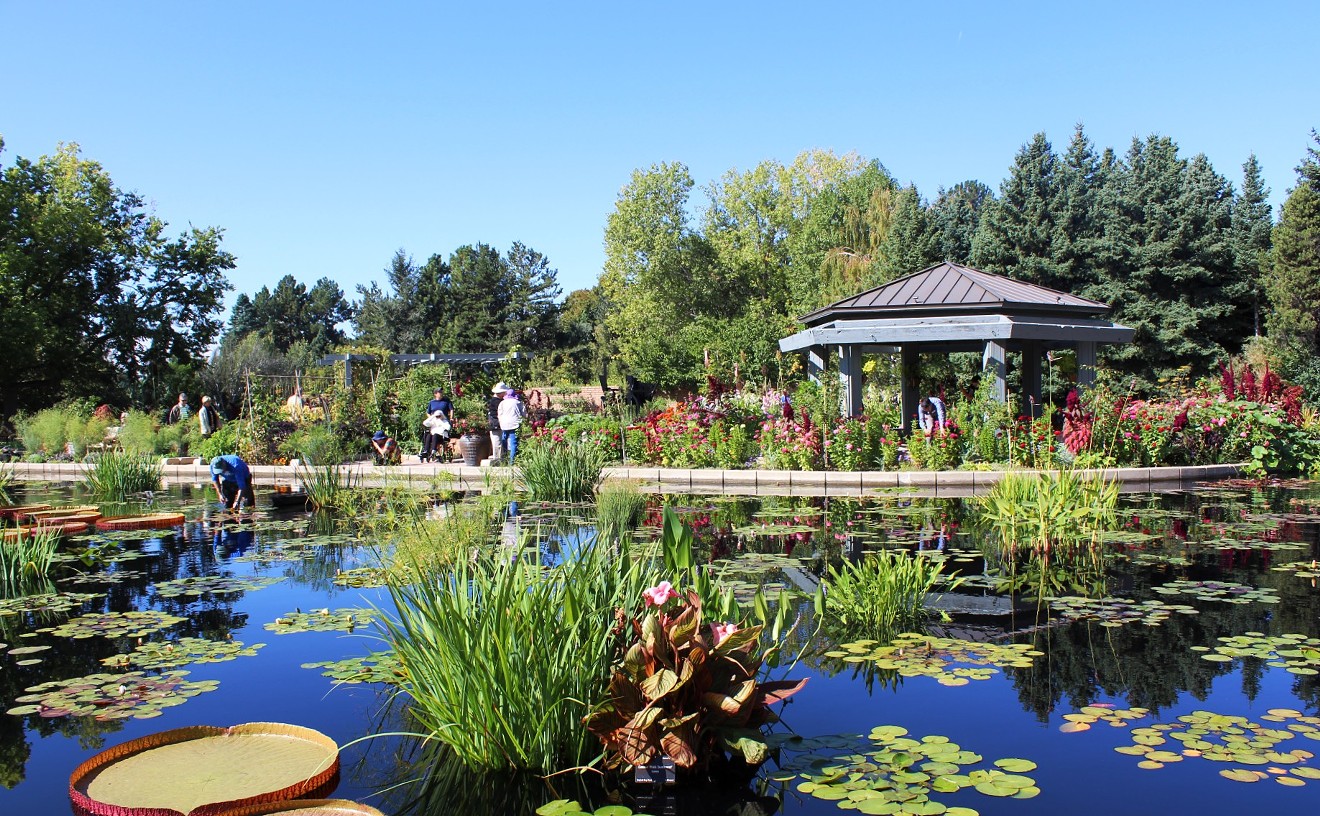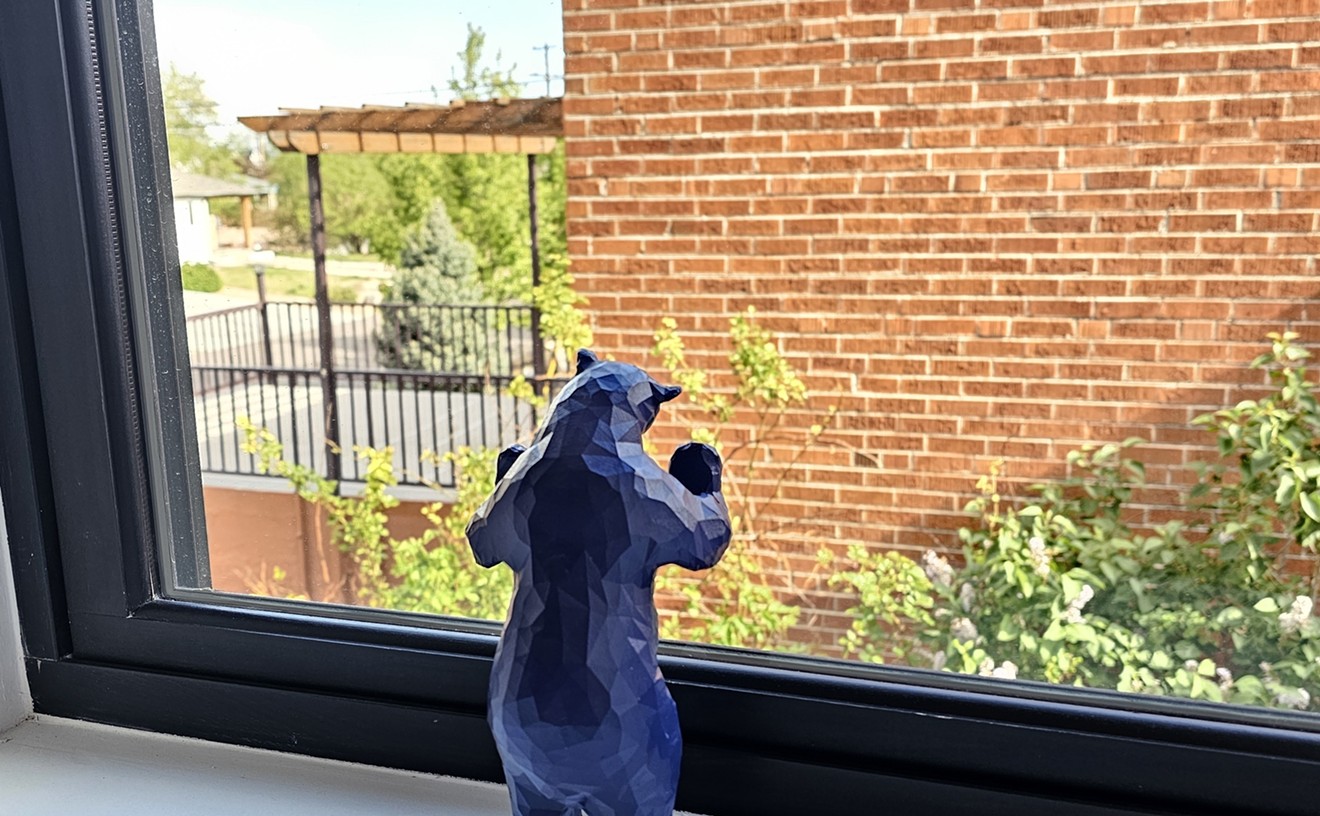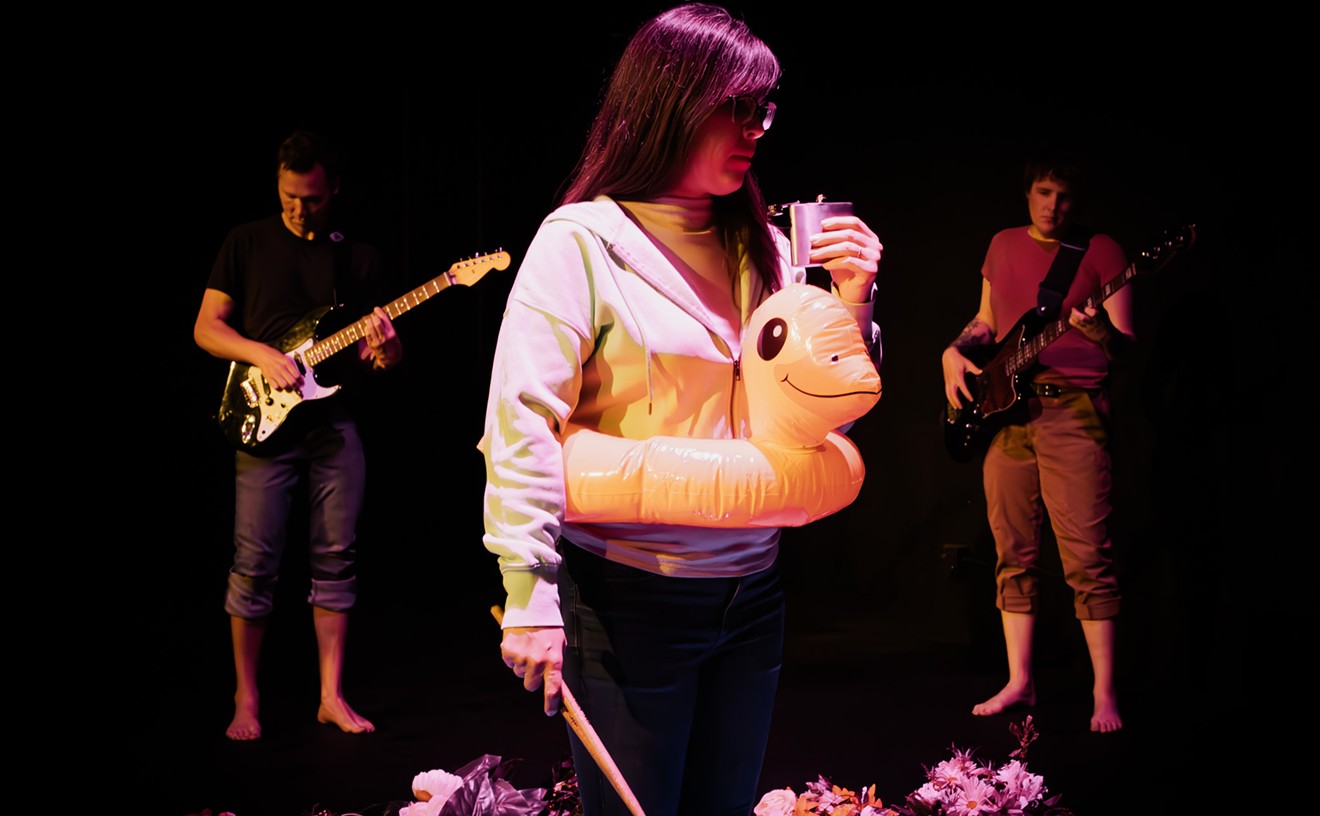How does Denver’s garden grow?
When Denver International Airport finally opened 22 years ago — after endless delays, rumors of $50-plus cab rides downtown and stories about a suitcase-eating automated baggage system — the C Concourse felt like a vast wasteland compared to the bustling B Concourse, where United had its major hub, and the A Concourse, where feisty Frontier was scrambling to fill the gates left empty by Continental’s withdrawal from the project. This was the area less traveled by, and as you came up the escalators from the train and encountered Michael Singer’s “Hidden Garden,” so reminiscent of ancient ruins with its concrete features hidden by foliage, it seemed mysterious and somehow fitting.
Today this concourse, home to Southwest, is crammed with travelers, and Singer’s piece looks more mysterious than ever. Most of the plants have died, and the ruins appear to be, well, ancient ruins. Or at least 22-year-old ones. For travelers, the piece is as haunting as those gargoyles by the baggage claim, as inexplicable as the laser-beam eyes of “Mustang.” In short, it does what art is designed to do: make people think and wonder. Here’s what they should be wondering now: Why does Denver want to get rid of “Hidden Garden”?
DIA is preparing for a major remodel of the Jeppesen Terminal, though exactly what form that remodel will take has yet to be announced. The private company that got the contract late last year has not revealed its plans, though there are hints that security will move out of the Great Hall and up to the ticketing area on level 6, since technology (read: making the passengers do all the check-in work themselves) has made much of the counter area superfluous. Some of the space under the tent roof in the Great Hall may still be open to the public, but most will likely be a secure area catering to that captive market of travelers who’ve survived TSA, with time on their hands and some cash in their pockets. They’ll encounter far more shops, perhaps a few Colorado-style amenities — a zipline, maybe, or a climbing wall — and less art.
At the April 4 meeting of the Denver Commission on Cultural Affairs, commissioners received a Request for Deaccession report from DIA that proposed removing three of the airport's original pieces, part of a $15 million-plus art collection made possible by Denver’s policy that sets 1 percent of every major construction budget aside for art — a collection that earned DIA the title "Best U.S. Airport for Art" from USA Today four years ago. And with new pieces added because of the Westin and A Line projects, it's only gotten bigger since then...until now.
The first piece up for deaccessioning, “SkyDance,” by the late Anna Valentina Murch, was supposed to throw shadows on the ceiling of the terminal, but never really worked The second, the terminal floor designed by Jaune Quick-to-See Smith and Ken Iwamasa, was expanded from original plans to add a section in the center of the space, a replacement for “Mountain Mirage,” the fountain that was supposed to create a silhouette of the mountains but instead created a mess on the floor of the train platform. “Mountain Mirage” was the first, and so far only, piece to be deaccessioned at DIA. Removing the floor “will ensure DEN is able to meet today’s security and passenger flow needs and accommodate the future growth of airlines and passengers,” the report says — even though the plans for that space are still as secret as that hidden enclave of Martians who reportedly live under baggage claim.
And the third piece now on the chopping block? Singer’s 1994 piece at the core of the C Concourse. Maintenance has become excessive, the airport says; taking care of the plants alone costs $15,000. And it leaks: “The garden is located above the concourse passenger train, perhaps not the best decision the airport made,” the report notes. Those leaks, however, are not the reason that the escalators on the C concourse seem to be in a constant state of repair lately. (“They never work,” confided one traveler who squished her way onto the elevator Monday morning.) According to DIA spokesman Heath Montgomery, the problem with C’s escalators is age; they’re 22 years old, and it’s simply time for them to be replaced.
Art, of course, is supposed to get better with age. That’s one reason city policy requires that a piece of public art be in place for at least five years before deaccessioning is even considered. Over time, viewers become accustomed to a work, even grow to love it. That’s certainly been the case with Luis Jiménez’s “Mustang”; despite all the controversy when the killer horse sculpture was installed outside the airport, it passed its fifth birthday a few years ago without a single suggestion that Blucifer go galloping off into the sunset.
Singer, whose reputation has only grown since he received this commission, designed “Hidden Garden” as an oasis for weary travelers, a way to bring nature into an otherwise sterile setting. “The garden is covered with vines, ferns, all manner of growth. It becomes a living ecology, and therefore a complete contradiction to its surroundings,” he wrote, noting that he “took what would have been a usually antiseptic airport zone, made it smell, made it wet, and made it grow; and gave life that you don’t get in places like an airport.”
Here’s the description of the piece on flydenver.com, the airport’s official site: “This installation utilizes plant material, along with sculptural and architectural elements, to convey a connection to human history, the cycle of life and the natural world. Layers of patterns and combined elements of wood, stone, cast concrete panels and plant life repeat throughout the design of the garden and the floor below, implying a process of discovery and an accumulation of meanings.”
So what’s the meaning of DIA wanting to get rid of it now? It’s not in the way of any plans for the Great Hall. The report returns again to maintenance of the work, noting that the original commission was for $415,000 and the cost more than doubled; another $800,000 has been spent for repairs. But is a real fix impossible? Have experts been brought in to analyze the structure? Could the crew at the Denver Botanic Gardens, who not only understand how to make plants grow in hostile settings but how to install water features without springing a leak in the budget, prune “Hidden Garden” back to health? Singer himself is reportedly not happy that the airport is so willing to get rid of his work without trying to save it.
If “Hidden Garden” goes, how long will it be before DIA asks to deaccession “Dual Meridian,” the piece by David Griggs at the core of the A Concourse, so it can be replaced by a giant merchandise mall? Or maybe “Mustang” can become a drive-through coffee shop; the horse’s laser eyes could froth the milk on that latte.
The commissioners will discuss the proposed deaccessioning again at their May 2 meeting; if they approve the package, the decision moves to the head of Denver Arts & Venues, Kent Rice. But while the Great Hall floor may well be doomed by plans for the terminal remodeling that could get under way as early as this fall, “Hidden Garden” is well out of the way of that project. It could bloom again.
Denver keeps growing, and growing, but the city still takes pride in all its public parks and garden spots. Singer’s piece should be one of them.
[
{
"name": "Air - MediumRectangle - Inline Content - Mobile Display Size",
"component": "12017618",
"insertPoint": "2",
"requiredCountToDisplay": "2"
},{
"name": "Editor Picks",
"component": "17242653",
"insertPoint": "4",
"requiredCountToDisplay": "1"
},{
"name": "Inline Links",
"component": "18838239",
"insertPoint": "8th",
"startingPoint": 8,
"requiredCountToDisplay": "7",
"maxInsertions": 25
},{
"name": "Air - MediumRectangle - Combo - Inline Content",
"component": "17261320",
"insertPoint": "8th",
"startingPoint": 8,
"requiredCountToDisplay": "7",
"maxInsertions": 25
},{
"name": "Inline Links",
"component": "18838239",
"insertPoint": "8th",
"startingPoint": 12,
"requiredCountToDisplay": "11",
"maxInsertions": 25
},{
"name": "Air - Leaderboard Tower - Combo - Inline Content",
"component": "17261321",
"insertPoint": "8th",
"startingPoint": 12,
"requiredCountToDisplay": "11",
"maxInsertions": 25
}
]













